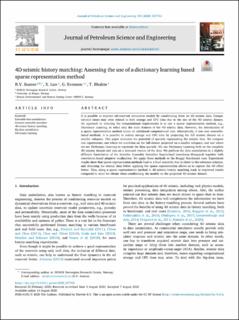4D seismic history matching: Assessing the use of a dictionary learning based sparse representation method
Journal article, Peer reviewed
Published version

Åpne
Permanent lenke
https://hdl.handle.net/11250/2727220Utgivelsesdato
2020-12Metadata
Vis full innførselSamlinger
- Department of Mathematics [939]
- Registrations from Cristin [9791]
Originalversjon
Journal of Petroleum Science and Engineering. 2020, 195, 107763. 10.1016/j.petrol.2020.107763Sammendrag
It is possible to improve oil-reservoir simulation models by conditioning them on 4D seismic data. Computational issues may arise related to both storage and CPU time due to the size of the 4D seismic dataset. An approach to reducing the computational requirements is to use a sparse representation method, e.g., Dictionary Learning, to select only the main features of the 4D seismic data. However, the introduction of a sparse representation method incurs an additional computational cost. Alternatively, if one uses ensemble-based methods, it is possible to reduce storage and CPU time by projecting the full seismic dataset on a smaller subspace. This paper evaluates the potential of sparsely representing the seismic data. We compare two experiments, one where we condition on the full dataset projected on a smaller subspace, and one where we use Dictionary Learning to represent the data sparsely. We use Dictionary Learning both on the complete 4D seismic dataset and also on a denoised version of the data. We perform the data assimilation in a slightly different formulation of the Iterative Ensemble Smoother Regularized Levenberg–Marquardt together with correlation-based adaptive localization. We apply these methods to the Brugge benchmark case. Experiment results show that sparse representation methods lead to a final ensemble that is closer to the reference solution, and denoising the seismic data before applying the sparse representation allows us to capture the 4D effect better. Thus, using a sparse representation method in 4D-seismic history matching leads to improved results compared to what we obtain when conditioning the models on the projected 4D seismic dataset.
